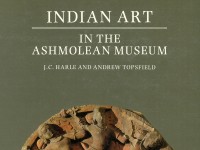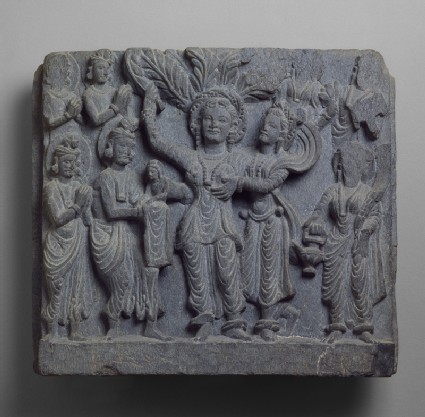Indian Art in the Ashmolean Museum
A catalogue of the Ashmolean’s collection of Indian art by J. C. Harle and Andrew Topsfield (published Oxford, 1987).

Publications online: 143 objects
- Reference URL
Actions
Relief depicting the birth of the Buddha
-
Literature notes
Since the Buddha was a historical figure, incidents in his life, as in that of Christ, have always been a favourite with painters and sculptors. Of these, his birth numbers amongst the most important, along with his conception, his achievement of illumination under the Bodhi-tree at Bodhgaya, the first sermon preached in the deer park at Sarnath, the great miracle at Śrāvastī, and the parinrivāna or death, of which the Museum holds the companion piece to the birth.
Traditionally, the Buddha is shown being born from the right side of his mother, to be received by the god Indra. He wears a halo, as do the heads of several other male figures, all presumably Hindu gods. Their presence attests to their role in Buddhism: they are simply enlisted as particularly eminent worshippers of the Buddha.
Māyā, the Buddha’s mother, is seen holding a frond of the highly stylised foliage canopy above her. This refers to the immemorial fertility association in India between a young girl and a tree, recorded in countless carvings (sālabhañjikās) where a young woman bends or clings to the foliage of a tree. On her proper left stands a young woman carrying a pot of consecrated water, essential at such an event, and probably a stick of sugar cane. The upward billowing curve of her scarf is a Western Asian and classical motif.
The attempt at illusionist carving and the treatment of the draperies all strongly suggest Roman reliefs of the first and second centuries A.D. The influence of the classical west is to a greater or lesser degree all-pervasive in Gandhara. At the same time the costumes and turbans are Indian, with the exception of Māyā’s tunic-like upper garment, which is ethically Kuṣāṇa. -
Description
Standing in a grove, Queen Maya gives birth to Prince Siddhartha Gautama, the future Buddha, from her right side. The infant is received by the god Indra, while other deities stand in attendance.
-
Details
- Associated place
-
Asia › Pakistan › North-West Frontier Province › Mardan district › Sikri (possible place of creation)
- Date
-
late 2nd century - early 3rd century AD
Kushan Period (AD 50 - 600)
- Associated people
-
the Buddha (active c. 560 BC - c. 486 BC) (subject)
- Material and technique
- grey schist
- Dimensions
- 37 x 42 x 12 cm (height x width x depth)
- Material index
- Technique index
- Object type index
- No. of items
- 1
- Credit line
- Presented by the Reverend J. C. Murray-Aynsley, 1911.
- Accession no.
- EAOS.3
-
Further reading
Harle, J. C., and Andrew Topsfield, Indian Art in the Ashmolean Museum (Oxford: Ashmolean Museum, 1987), no. 17 on pp. 14-15, pp. 22 & 39, illus. p. 15
Harle, J. C., The Art and Architecture of the Indian Subcontinent, Pelican History of Art (Harmondsworth: Penguin, 1986), fig.58
Branfoot, Crispin, ‘Pilgrimage in South Asia: Crossing Boundaries of Space and Faith’, Ruth Barnes and Crispin Branfoot, eds, Pilgrimage: The Sacred Journey (Oxford: Ashmolean Museum, 2006), p. 56, illus. p. 56 figs 50 a & b
Oxford: Ashmolean Museum, 2006, Pilgrimage: The Sacred Journey, Ruth Barnes and Crispin Branfoot, eds. (Oxford: Ashmolean Museum, 2006), p. 56, illus. p. 56 fig. 50b
Location
Objects are sometimes moved to a different location. Our object location data is usually updated on a monthly basis. Contact the Jameel Study Centre if you are planning to visit the museum to see a particular object on display, or would like to arrange an appointment to see an object in our reserve collections.
Publications online
-

Indian Art in the Ashmolean Museum
Since the Buddha was a historical figure, incidents in his life, as in that of Christ, have always been a favourite with painters and sculptors. Of these, his birth numbers amongst the most important, along with his conception, his achievement of illumination under the Bodhi-tree at Bodhgaya, the first sermon preached in the deer park at Sarnath, the great miracle at Śrāvastī, and the parinrivāna or death, of which the Museum holds the companion piece to the birth.
Traditionally, the Buddha is shown being born from the right side of his mother, to be received by the god Indra. He wears a halo, as do the heads of several other male figures, all presumably Hindu gods. Their presence attests to their role in Buddhism: they are simply enlisted as particularly eminent worshippers of the Buddha.
Māyā, the Buddha’s mother, is seen holding a frond of the highly stylised foliage canopy above her. This refers to the immemorial fertility association in India between a young girl and a tree, recorded in countless carvings (sālabhañjikās) where a young woman bends or clings to the foliage of a tree. On her proper left stands a young woman carrying a pot of consecrated water, essential at such an event, and probably a stick of sugar cane. The upward billowing curve of her scarf is a Western Asian and classical motif.
The attempt at illusionist carving and the treatment of the draperies all strongly suggest Roman reliefs of the first and second centuries A.D. The influence of the classical west is to a greater or lesser degree all-pervasive in Gandhara. At the same time the costumes and turbans are Indian, with the exception of Māyā’s tunic-like upper garment, which is ethically Kuṣāṇa.
Galleries
Notice
Object information may not accurately reflect the actual contents of the original publication, since our online objects contain current information held in our collections database. Click on 'buy this publication' to purchase printed versions of our online publications, where available, or contact the Jameel Study Centre to arrange access to books on our collections that are now out of print.
© 2013 University of Oxford - Ashmolean Museum



